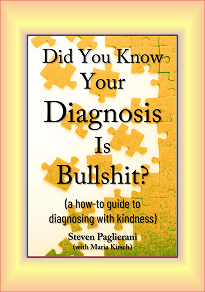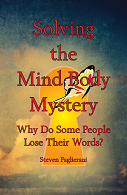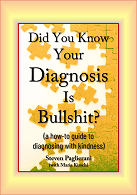
Did You Know Your Diagnosis Is Bullshit?
Steven's latest book, Did You Know Your Diagnosis Is Bullshit (a how-to guide to diagnosing with kindness) is now available on Amazon and Barnes and Noble. This time, instead of teaching therapists how to help people make breakthroughs, this book is aimed at the diagnostician in all of us. The point of this book? To teach people to understand, and be a part of, the diagnostic process. But rather than rely on ill-defined words and terms, in this book, diagnositics use easy-to-recognize colored lines, each of which has a knowable shaped.
This is where the true power to change lives exists. It exists in being oneself.
What Makes This Book Different?
All previous diagnostic manuals rely on, what for human nature, is a seriously flawed science. They all base their claims on statistics, a math valid only for large groups. Yet these manuals all claim to be able to diagnose individuals. Talk about cold-hearted. They treat all people with similar symptoms as if these people are all the same person.
What's different in this book? The science used to describe people, for one thing. All diagnoses described here are measurably specific to each suffering person. Also, all terms are defined fractally, using colored shaped lines and spaces. No more empty words or phrases. Only easily identified, visual definitions.
Amazon | Barnes & Noble | Amazon UKAnd the Old Site (the Making Changes site)?
Currently, while the old site is still open for business, it's slowly being revised. After all, it's been up since the mid 1990's. So there's a lot of content to consider. Much of this content is what led to these books. So much of it will remain as it is. This includes many articles on personality and the nature of wounds and healing.
Making Changes (a scientific look at how ahas affect health, healing, human nature).
What is Depression? (a hint: It's not sadness)
Real scientific discoveries do not have loopholes. Either they apply equally to all cases or they're flawed. In his new book, The Science of Discovery, Steven claims most present day scientific discoveries cannot pass this test—not because scientists don't try but rather, because of flaws in their method.
What if they had a method which could pass this test though? Is this kind of method even possible? He claims it is. And in this video, he offers a good example of something he discovered with this new method, a "no loopholes" alternate view on something we all experience from time to time: the experience of depression.
Will Steven eventually expand on this kind of content, for instance, in the sequel to Book IV? Time will tell.
Transcript of the Video
Over the years that I have been a therapist, many times, people have come to me to talk about being depressed. It's probably one of the more common things people talk about. And whenever that happens, I don't immediately ask them about their life. I don't ask them what is going on. I start pretty much with the same questions every time. And that question has to do with the word "depression" itself. I ask them what do they mean by depression. What do they think depression is?
Well, why do this? Well, for one thing—and this is one of the main things—we have built into our nature a series of three filters which, if we don't see these three qualities in the material we're talking about, or exploring, and so on—certainly in therapy—we tend to not retain the information. Or even see it as important. And the three qualities are a focus on logic, a focus on answers, and a focus on suffering or brokenness. Here, the focus on logic is the basis for most talk therapy psychology. The focus on answers is the central focus for modern science. And the focus on suffering or brokenness is the focus of medicine.
Psychology, Science, and Medicine
So psychology, science, and medicine. And what I'm saying is that I look past these things. Together, they narrow your focus. And I try to help people by expanding their focus, including a person who is depressed.
How do I begin? Generally, I ask them questions and I gather information. And they tell me things like, OK, depression is sadness. I'm sad a lot. I cry a lot. I don't want to get out of bed. I sleep a lot. I don't feel motivated. I have no energy.
OK, all of those things are symptoms that people do associate with depression. But they are not depression. Not even close. Symptoms are not nature. Symptoms are things we see as a result of being in that state of your nature.
So what we're going to be talking about today is what I show them each and every time when I start working with somebody who has now raised depression as an important thing they want to work on. In general, I, actually—over the years; almost 30 years now—have drawn a little drawing. And in almost every case, people say to me, "wow, I can understand this now."
So today we're going to be doing some variation of that drawing. And I'm going to be using slides. I don't know how many I have—something like a dozen slides.
And so what I begin with is the first slide. And what I begin with is, I talk a little bit about how the heck you make a chart. How do you chart a person's life experience?
And I tell them instead of the whole experience, what we're going to do is we're going to talk about what I call life intensity. And as you'll see, there are four life intensities. And they have words most people will be familiar with.
The normal life intensity is what we go through when we're in a normal part of our life. The word depression happens to be a second intensity of life—very low intensity. The word mania; feeling manic, refers to the most intense life intensity. And a word that many people are not familiar with, the word dysthymia—a Greek origins where "dys" is something that's not so good and "thymia" refers to moods. So moods that are not so good.
So, four life intensities: normal, mania, depression, and dysthymia. And we're going to look at them as life intensities, not as diagnoses.
The Backdrop to the Slides
OK, so let's start with the backdrop to all the slides. All the slides will use the same basic design. And the design begins on the left hand side.
There's a vertical continuum. And this range is from mania at the top to depression at the bottom. Somewhere in the middle and stretching on either side of the midline is normal. And then below the midline and below normal— but above depression—is dysthymia.
So mania, normal, dysthymia, depression. Those are the four life intensities. And they are placed on this continuum—a vertical continuum. And you'll see what that means in a moment.
At the bottom—horizontally across the bottom of the drawing—is another continuum. But it actually is, if you see, it's got a one-headed arrow at the right hand side of it.
This is the arrow of time. So it indicates that what's going to be drawn on each of these pages happens to be an event unfolding. The amount of time is an averaged amount of time. It could be an hour, it could be a day. It really doesn't matter, because the patterns are the same within that kind of time frame.
So let's start with the first slide.
The Word Depression
And so the first slide that we're going to talk about is the life intensity of depression. And so, if you look at the vertical continuum on the left side, you see that depression exists at the very bottom of the line.
It may be in the bottom eighth of the line.
Now if you look at the shape of the line, which is important, you see that the line doesn't vary very much. On the line, there are two factors—two measurements about the line. The one, there is a blue line—in this case, it's on the top—and it goes from peak to peak, a cycle of this type of pattern. And that's the time period. In this case, it almost goes across the whole page. Then toward the right side of the page, there is a green line that slants up very slightly. And this is the onset ramp. And that refers to how rapidly change happens in this.
So we're looking at the shape of depression—the life intensity of depression.
Now think about the word depression itself. Often when people come—as I said—they tell me about their symptoms thinking that's depression. But in truth, depression—if you think about taking all your life experience, regardless of what the feelings are, and pressing that life experience into a small space—that's depression.
So the depression itself is really "pressing your life experience down into that small space."
What happens when you do that?
Well, things change very little. In fact, you can very often feel almost no change, or detect no change. And this is a part of what causes symptoms of depression. Hopelessness comes directly from the experience of no change. But there is something else. And the vertical line, where it's going from mania to depression—we're now looking at the bottom of this line. Besides the amount of change—the range and so on; the shape of the line—it also has to do with what is on the screen of your mind, in the sense of how visual or how blank your mind is.
So if we were talking about the top end of this line—the mania end of the line—sometimes I talk about it as if it's like what you'd see if you were riding on a roller coaster.
Change happens very quickly and very vividly.
And at the bottom of this, the mind experiences something that looks like the screen of an Etch-A-Sketch pad—the child's drawing game—where the screen looks gray and white and nothing is on it, and you press on it and it makes a temporary drawing.
But the page itself is this gray-white nothingness. And so depression is a mind that is filled with this gray-white nothingness. And almost no visual material—none at all really—none to speak of.
Comparing Depression to Normal
How is this different from normal? What would it be like if we were talking about a comparison?
This slide shows a comparison of what normal looks like.
So for a moment, just focus on the normal part of it.
We talked about the depression line. Now, let's talk about the normal line. Now if you look at this line, the first thing that you see is that it varies.
If we were thinking about this as a surface—the ground that you are walking on—the depression is barely anything. You know, it's relatively a flat surface. But in the normal line, there are hills and valleys and there are no sharp lines. But there's a significant amount of difference between the peaks and the valleys.
Also, it's centered almost right on the midline between the depression and mania intensities. And so this is a middle, moderate amount of intensity.
The two qualities to notice and compare—one of them is the time period, the blue line from peak to peak. And you notice how it is quite a bit shorter than the depression. And then, the onset ramp—the green line, which is slanted up. You can see that it's quite a bit more slanted. The slope is quite a bit steeper then depression. Quite noticeable.
If you now look at these two lines and if you compare them in your mind, you're seeing the literal difference—the essential difference—between a normal life intensity and the life intensity of depression. And most people when they see this go—if they had been depressed—"oh." And the line itself represents their inner experience so well that many people go, "wow."
The one for normal is a little harder to experience. Unless you pay close attention to yourself, you never really look at it quite this way. But spending a little time and doing it by comparison, like this case between depression and normal, usually makes this difference become quite apparent.
Mania Compared to Normal
So if we were to now move on and talk about mania, we're going to the opposite end of this vertical line. And at the top of the vertical line, if you take a look at this line, you notice how sharp it is—how many peaks and valleys that are there. And quite honestly, it's easy to see that this is very intense—ups and downs in a jerky manner.
And again, look at the two qualities we've been looking at—the time period and the onset ramp; the slope.
And so the time period is very, very brief between peaks. And if you now think about the time period in the normal wave and the time period in the depressed wave, by comparison, it's intensely brief. And if you look at the slope, the slope is very sharp.
Imagine going up and down a roller coaster like that. Quite honestly, I'm not sure that I could keep my eyes open. But many people do. And it is very intense if you are able to keep your eyes open. And that rapidly changing, very vivid visual experience is really the heart of mania.
Perhaps that's why the word mania comes from a Greek word which means inspired. Notice it didn't mean, originally, that we were broken. It wasn't a part of a disease. It was inspiration. Very vivid, rapid, visual scenes going on your screen of your mind.
So compare that to normal. And now once again, when you look at this slide and you look at mania on the top, and then you look at normal life intensity in the middle, it's really apparent what mania is just from the shape of the lines. By doing this, we're managing to look past the idea of the medical view where it's limited to brokenness.
Also, we're not looking for answers. We're looking for what we can describe to describe the nature of these things. And we're not coming to this with logic. We're coming to this with years and years of observations, including observations of people who this is happening to—and their self-observations.
Mania Compared to Depression
Now before we go on to dysthymia, let's look at the slide for a comparison of mania and depression.
So most people have heard of this-- probably prescribed too much—there is a condition called manic depression. And from the words, it sounds like it's kind of half mania and half depression. It's nothing like that. Quite honestly, when you actually see a person like that, the mania is the main portion of their life. For the most part . . . most manic depressions . . .
Excuse me, the depression is the main part. And the mania is something that happens on a cycle. The person will cycle up through dysthymia, up through normal, and they'll keep going and they'll hit this manic state where they're exactly like that line. Very rapid changes. Very steep changes. Very, very visual, very vivid mind.
And then they fall. They fall back into depression. And so they have some kind of dysthymia. But most of the time, they are at the bottom of that line.
So in this case, we're looking at these not as a condition, not as a disease or illness, but rather simply as the two most extreme life intensities—mania and depression. And if you look at the lines, the intensity is very obvious. And it's very obvious how much visual material is in the mind for each of those two.
So What is Dysthymia?
So moving on to dysthymia.
This one is the least known. And yet, it affects an awful lot of people.
People who know me know that I spent much of my childhood and my 20's in dysthymia. At the time, I had no idea that I was abnormal at all. I basically showed up for life and did fairly well in school and paid my bills and so on. Got married. Had two children
But for the most part, when I look back now, I can look at this line and I can see, yes, that was very much, me.
One of the first things to notice is the midline. It's the line wherein, if you notice that you're happy, if you go above it.
Now if you look at the dysthymia intensity line, you see that pretty much nothing goes above that midline.
On the other hand, if you compare this to depression, which is basically a flat line—this line has some hills and valleys. It has some changes.
But they're not anywhere near as intense as a normal life experience.
People with dysthymia rarely even know the difference—especially if they've had it for a long time—because they function fairly well.
People who are depressed have trouble functioning, period.
But people who have dysthymia—which medical people put into the depression category—with people with dysthymia, a lot of the people around them wouldn't know. They would just see this person as a less intense person—a laid back person in some way.
But in particular, if the mood doesn't go across that midline, there's not noticeable happiness. Not really.
Comparing Dysthymia to Normal
So what does this look like if we compare this with normal? It's an interesting thing to compare a normal life intensity to a dysthymic life intensity. But the two qualities help us to look at this because there are a lot of similarities.
First, notice the placement on the vertical axis which indicates how gray the mind is—the lack of pictures—lack of vivid material, visual material. Whereas, a normal life intensity is much more visual. Yes, you're not walking around having spiritual experiences. But you are seeing quite a bit material in your mind. When somebody asks you to remember things, often, you can remember. When you're trying to recall something that you need to do, you may look up into your head and recall some images.
With dysthymia, there's very little of that—not none. But very little.
Now if you look at the time period, dysthymia unfolds in cycles that are much longer—noticeably longer—than normal cycles of ups and downs. Also, the onset ramp is not as steep for dysthymia when compared to normal. So in a way, it's kind of like dysthymia is almost normal, or normal is just above dysthymia in one way or another. But in truth, they are in fact quite different intensities.
Comparing Dysthymia to Depression
Now if we compare dysthymia to depression—and they're both called depression in a lot of the diagnostic manuals—if you look at the difference, clearly there's a difference.
The flat line of depression, wherein nothing changes—and the very gradual line of dysthymia, where things do change. And yes, it's so gradual that if you were looking to make a change inside you—or in your life—even if you accomplish it, it would be so gradual that it wouldn't spark much reaction inside of you. It would be, OK—it wouldn't be nothing. But you would not have a normal reaction.
And when you look at those two lines, clearly you can see the difference.
Comparing the Cycles of Change
If you look at this slide, this slide compares how long the cycles of change are. And this is the time-period part of the intensities.
So in the top, there's this brief cycle of mania. It's very short.
Below that is the cycle of normal. That's quite a bit longer.
Below that is the cycle of dysthymia, which is again, quite a bit longer.
And then below that is the cycle of depression. Although truthfully, calling that a cycle kind of stretching it, because the line barely moves. So those are the four time periods.
Then there is the other factor—the four onset ramps. And if you just simply look at how steep or not steep the four lines are, you can see that it's very steep for mania, it's somewhat steep for normal, it's quite a bit more gradual for dysthymia, and it's almost flat for depression.
The Four Life Intensities: a Story
OK, so let's put those things together. So here we are. And what you're really looking at is not symptoms, not anything wrong. These are actually just the four basic patterns that we all experience at times in our lives.
So for instance, let's say that you had a daughter who is a senior in high school and she is quite smart. And you're able to pay for college for her. You've been saving for a long time and she's applied to seven colleges—all good ones. And the one that she wants to get into is Harvard. That's her choice. But she's already been accepted at two or three others.
And this afternoon an envelope comes from Harvard and you can see that her life intensity is high. As she goes for the envelope, she's speeding up. You can see a difference in her eyes, in her movements, in her speech.
She opens the envelope and she starts reading, and her hands go, and her eyes go, and she's jumping around, and her bodies moving. That's mania. She's just got accepted to Harvard. We don't look at this as something wrong, because there's not something wrong, it's something good. Something normal. It's mania. She feels inspired. That's what the Greeks would look at—its mania.
Now, of course, we're not talking about that it gets to the point where she loses touch with all reality. But she's lost touch with anything other than, wow, I got this thing that I so wanted. OK, so now over the next few days she tells enough people and she kind of goes back down to the normal life intensity.
And since this has been a period of time where she's been waiting to know whether she got in—and there have been a number of letters that have come from other places and so on, but this was the last one—then there is some degree of dysthymia after a point. Because this is an after the excitement kind of a feeling. And so she's kind of mellowed out a little bit below normal a few days or a week later.
Now, a week later another letter comes. And it's from Harvard again. Only this time the letter says that there's been an error, and she's been accepted, but she's not going to be able to enter for a year. Now, even the way that I'm saying this is slower. But can you imagine what she'd look like as she was reading the letter?
You'd physically see her slow down her movements, her thoughts. She might well up with tears. She might just sit down slowly and so on.
So now she's moving into dysthymia—the other side of normal from mania. And this is absolutely normal. Absolutely. And within an hour or so, as it's really getting her, she may actually feel depressed and just go up to her own and really just be very zoned out.
She may cry at first, which is again, in the area of dysthymia intensity. But she will probably go to sleep early and not want to get up the next day. And she probably will feel quite depressed. Again, is this brokenness? Is there something wrong with her? Not at all. This is a normal reaction to such a big disappointment.
What's important to see is how she's going through all of the life intensities and reacting to life experiences that match those life intensities. That's what's very important. That's what makes them not a problem. Actually, it's health. The things that we're talking about aren't ordinary. So she's having extraordinary reactions, which is normal in those situations.
So when you look at these lines, what you might want to look at is to look past the words—the dictionary sense, or the medical sense, or the therapist sense. And just see them as these are things we all go through—these intensities. You know if it was your wedding day, believe me you would be going through a lot of changes. Everybody does. And part of those changes would be normal. Part of them would be dysthymic. There may be a point where you are depressed for times—like afraid, actually, and very blank. And there would be times when you certainly would be manic and everything.
You would be going through these changes quite a bit in the time leading up to that, maybe the week before, and the day of the wedding, and so on.
None of this is brokenness.
All of it is normal in human nature based on the kind of life experiences we're talking about.




.png)
